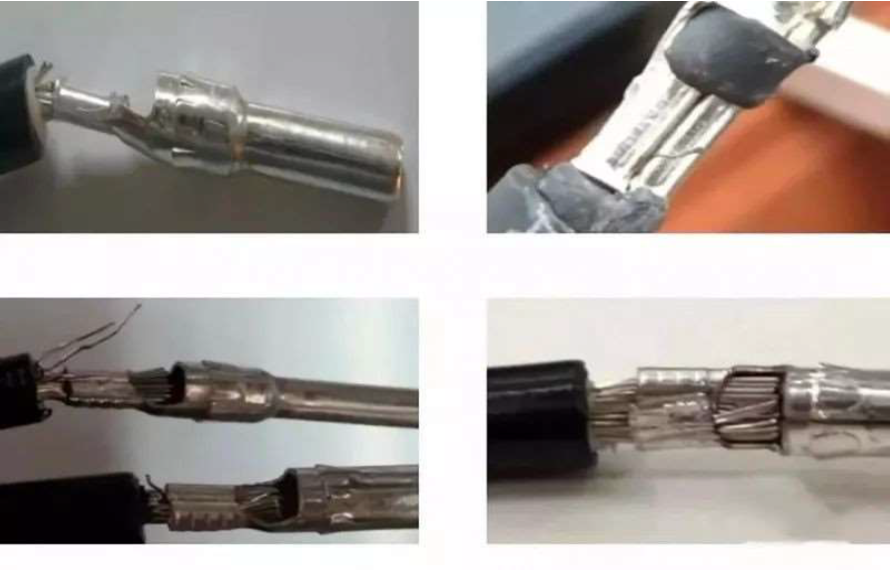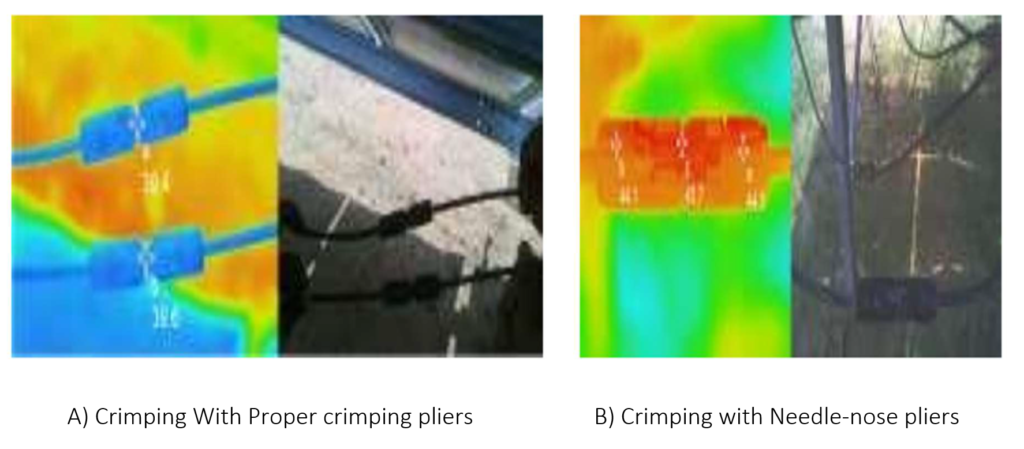Do You know Solar Crimping Tools for professionals? In a photovoltaic power generation system, photovoltaic connectors are mainly used in components, combiner boxes, inverters and the connections between them, most of which are installed in the factory, and the crimp quality is relatively reliable.
About 10% of the remaining connectors need to be manually installed at the project site, mainly referring to the need to install connectors at both ends of the photovoltaic cable connecting eachdevice.
According to the experience of many years of customer visits, due to the lack of training of on-site installation workers and the use of professional crimping tools, crimping irregularities are common, as shown below.

Types and characteristics of metal cores
The metal core is the main body of the connector and the most important flow path. At present, the vast majority of photovoltaic connectors on the market use a “U”-shaped metal core, which is stamped and formed from a copper sheet, also known as a stamped metal core which is very suitable for automated wire harness production.
Some photovoltaic connectors use an “O”-shaped metal core, which is formed by drilling holes at both ends of a thin copper rod, which is also called a machined metal core. The “O”-shaped metal core can only be crimped individually, which is not suitable for use in automated equipment.

Basic knowledge of crimping
Crimping is one of the most basic and common connection techniques.
Countless crimping occurs every day. At the same time, crimping has been proven to be a mature and reliable connection technology. Ideal length of cable stripping should be 12 mm to ensure proper crimping connection of the cable with the metal core.
Good to know: Locking solar connector – why is it now your ONLY choice?
Crimping process
The reliability of crimping depends largely on tools and operations, both of which determine whether the final crimping effect meets the requirements of the standard. Take the “U”-shaped metal core as an example.
It is basically a copper tin-plated material and needs to be connected to the photovoltaic cable by crimping. The crimping process is as follows:

It is not difficult to see that the “U”- shaped metal core crimping is a process in which as the crimping height gradually decreases (while the crimping force gradually increases), the copper sheet wrapped with the cable copper wire is gradually compressed. In this process, the control of crimping height directly determines the quality of crimping.
The control of the crimp width is not very important, because the crimp die determines the width value.

Solar Crimping Tools
The vast majority of photovoltaic connectors are installed in the factory through automated equipment, and the crimp quality is high. However, for connectors that have to be installed at the project site, crimping can only be done with crimping pliers. The original professional crimping pliers must be used for crimping. Ordinary or needle-nose pliers cannot be used for crimping nor can standard crimps.
Solar crimping tools Elkay and Elmex have a specialist Solar crimping tool (ESCCT) and a fully stocked Solar Toolkit (EMPVKIT) in their range.

Learn more: Solar Connector Guidelines: 7 vital tips for professionals!
Watch our unboxing video: The Elmex PV Solar Toolkit
Irregular crimping hazards
Poor crimping may lead to non-compliance with specifications, unstable contact resistance and sealing failure. It is a big risk point that affects the overall function and profitability of photovoltaic power plants.
Visual Comparison – crimping with proper crimping pliers vs with needle-nose pliers

Contact resistance Comparison

Thermal Comparison – crimping with proper crimping pliers vs with needle-nose pliers


How to make a Solar connection correctly with the correct Solar crimp tool
Elmex has developed solar straight connector with plug & Socket design suitable for 2.5, 4, & 6 sq.mm, size cables and are constructed using flame retardant engineering thermoplastic suitable for photovoltaic application and exposure to UV rays.
While small solar panels, commonly used for battery charging, may not require special connectors, larger terrestrial arrays for power generation involve higher currents and voltages and place special demands on both cables and connectors for safe operation.
The EMPV4 connectors incorporate a flexible watertight seal and are supplied as ‘male (plug)’ and ‘female (socket)’ types to minimize the chance of wrong connections. For proper seal, they require usage with the correct diameter cable, normally double-insulated (insulation plus black/red sheath) and UV protection (as UV rays tend to damage the connection).
Contact us today, and we can guarantee you get the appropriate partners and part numbers. This ensures the installation of compliant and safe Elmex connectors or Elkay's time switches and sensors.
 |
 |
Paul Onyett
General Manager – Elkay & Elmex |
Danny GladdishSpecification and Distribution Manager |
 |
 |
Karl Grant
Specification and Distribution Manager |
Richard BarnesSpecification and Distribution Manager |
 |
 |
Francesca Graham
Orders |
Steve Anderson
Technical Manager |





